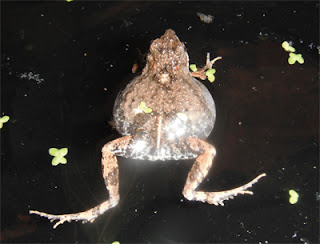Oh, well. Sometimes in life, you make mistakes, but as long as you learn from them, it's OK. I definitely will be triple-checking to make sure that I have the right treatment for each toad from now on!!!
So yeah, back to the original point of this post. I have 65 videos of toads running around arenas, looking for food. Now what am I supposed to do?
Lucky for me, I have this handy program called Ethovision XT that will make a path of where the toad goes and tell me all sorts of things about the path. It can tell me which bowls the toad visits and in what order. It can tell me how long the toad spends in what areas of the arena. It can even tell me how fast the toad is moving (or at least, it's average speed). But just like any computer program, it comes as a blank slate, and I have to tell the program all of the things I want it to record. Ethovision is kind of fun once you get the hang of it because it's all about creating 'zones', or drawing pictures. Here is how I decided what zones to draw in order to get the information I need:
First, I started with a blank arena:
Ok, that's it, right? Nope! There's all sorts of other information I might want to know, too. For example, I might want to know how much time the toad is spending around the margin, or wall, of the arena vs. in the middle (frogs and toads have a tendency to hang around walls). I'll draw a circle in the middle of the arena and mark the inside and outside as different zones:
I might also want to know how much time the toad is spending on the bricks and cinder blocks vs. on the ground. When I tested this arena in Texas, the 4 toads I used mostly stayed on the ground. It would be interesting to see if there is a difference between these toads and the toads in the lab. To do this, I can trace the blocks in the arena (in light yellow) and make them different zones that the ground:
I might also want to know if there is a side bias. A side bias could happen if the toads are particularly attracted to one part of the arena or another. Because our arena in Gamboa is outside and there are factors we can't control (like street lights and other frogs calling), it's important to know if the toads are staying in one part of the arena longer than the rest. To do this, I split the arena into 4 equal parts, like quadrants of a graph (in yellow):
The last thing I want to know is how long it takes the toads to first enter the arena (or leave the origin). This can be accomplished by drawing a zone that the toads have to pass through if they want to leave the flower pot (in green above).
And that's it! That's all the information (probably) that I want to know about where the toads go during the trials. Next I 'run' the trials through Ethovision, and it records the path of the toad and tells me things about where it goes.
I'm excited to see what happens - I wonder if the toads will follow the same path every time they visit the arena, or if they will go to different areas each time? What do you think? Do you think your answer depends on if there is food in the bowls or not?
























